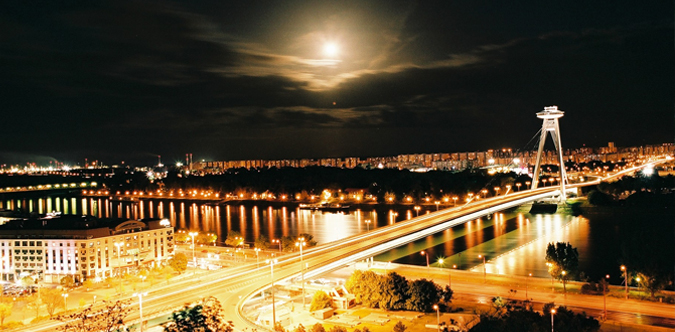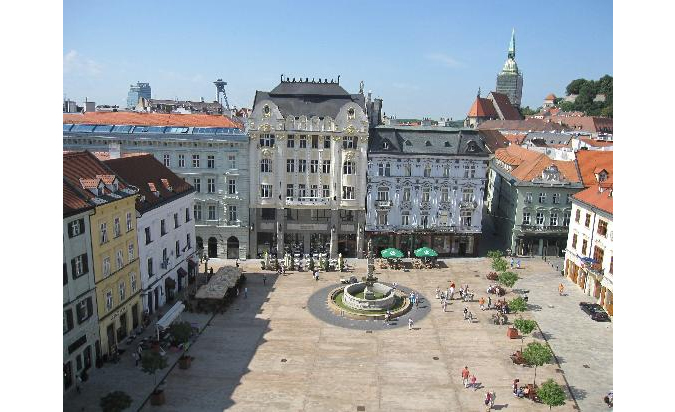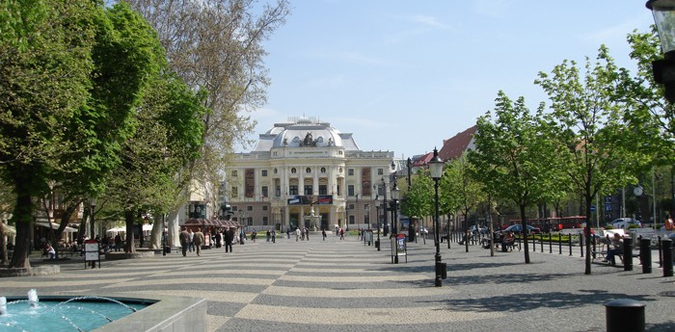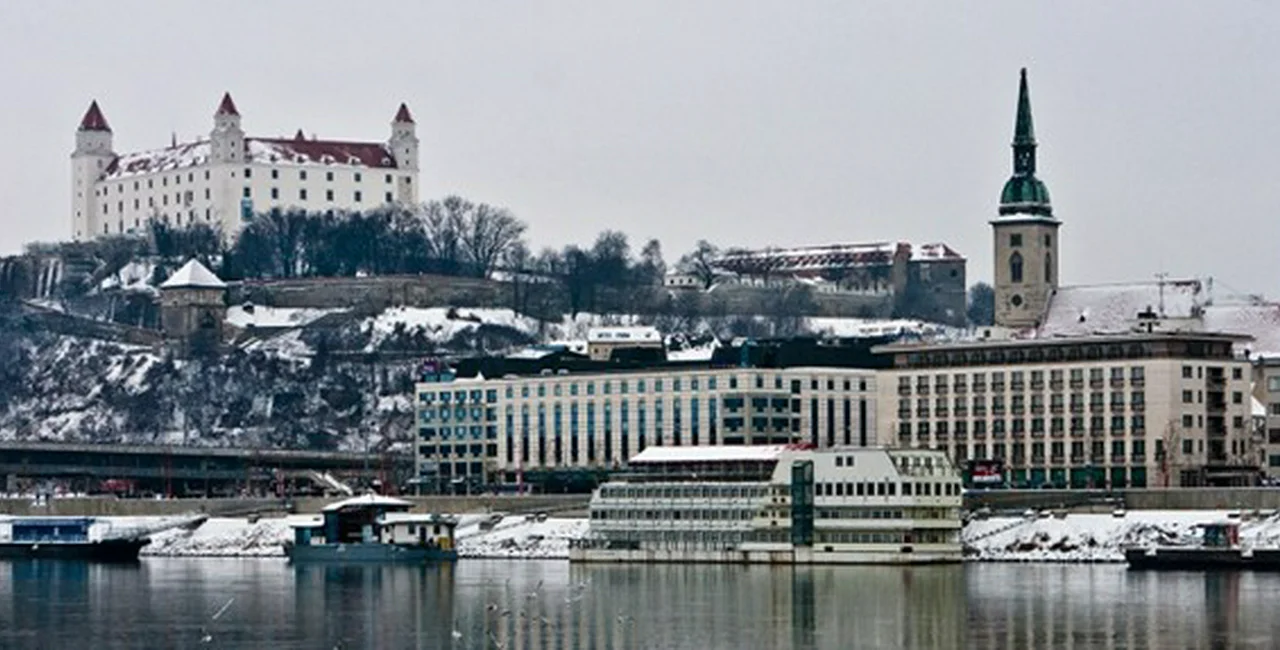With a population of around 450,000, Bratislava is one of Europe’s smallest capitals and therefore often dismissed as no more than a fun-sized version of Prague. Many travelers merely spend a tenuous few minutes in the city as it passes by their hermetically sealed Euro City train en route to Budapest or beyond. Yet Bratislava has a complex, multi-cultural story. It was a German and Hungarian city long before becoming the Slovak capital – relatively recently – upon the foundation of Czechoslovakia in 1918. And while the Old Town (Staré mesto) may be smaller than that of larger cities, and Bratislava Castle and Cathedral more modest than their Prague counterparts, the Slovak capital has its own particular draws.
These include beautifully restored buildings complemented by a network of engaging and civilized public spaces, which makes strolling around a real pleasure. Another benefit is that there’s no pressure in Bratislava to spend time frantically ticking off big-name attractions. What’s more the city is just 40 miles from Vienna.
GETTING THERE AND AROUND
Direct trains run from Prague, Brno, and Ostrava to Bratislava’s easily navigable main station, Bratislava hlavná stanica, located just off Pražská, immediately north of the city center. The station is connected to the center by tram (električka in Slovak), bus, and trolleybus.
Public transportation in Bratislava comprises the above modes during the day and buses during the night. As the center is very compact, the best way to see the city is on foot. However, if you need to travel further distances, you’ll need to use the public transport network, operated by Dopravný podnik Bratislava (www.dpb.sk). As in Prague, a flat fare system applies, and Bratislava is divided into two ticket zones. Bear in mind that inspectors don’t take kindly to simpering tourists pleading ignorance if caught traveling without a ticket.
TOURIST INFORMATION
The main tourist office BKIS is at Klobúčnická 2, beside the Primate’s Palace (see below).

WHAT TO SEE
Below we’ve listed some of the main sights in the compact, user-friendly Old Town.
Castle and Cathedral
A good starting point is the austere Castle (Hrad), which broods over much of the rest of Bratislava. The building is mentioned in records as far back to 970, although a medieval castle was later built by Emperor Sigismund as a fortress against the Hussites. The building was burned down in 1811 by drunken Austrian soldiers and later restored under Communism. Since 2008, the Castle has been undergoing another, more sensitive overhaul, and efforts have been made to integrate it with its surroundings and make them more attractive too.
So far, the most obvious sign of progress is the Castle facades, which have been repainted a glowing white. At the time of writing, the Castle was closed as part of the restoration, although it’s worth ascending to the entrance to enjoy the superb views over the city, especially to the futuristic New Bridge (Nový most, formerly Most SNP) spanning the wide River Danube. The sleek single span suspension bridge, incorporating a flying-saucer shaped structure (containing a restaurant) perched at the pylon apex, has become a symbol of the Slovak capital.
The Communist-era highway leads to the bridge and slices crassly through the Old Town, illogically severing it from the Castle. All of Bratislava’s Jewish quarter, below the Castle, was demolished to make way for the road. The area was home to a vibrant community before World War II, and you can learn about this vanished history at the Museum of Jewish Culture (Muzeum židovskej kultúry) on Židovská street.
Rammed up against the busy Staromestská highway and somewhat ignominiously accessed by a passage underneath it is the Cathedral (Dóm sv Martina). The dimensions and oddly proportioned tower make the plain structure look more like a grand parish church rather than a cathedral, but St. Martin’s served an important role as the coronation church of the Hungarian monarchs. The late Gothic interior is dignified and simple.
Michalská/Ventúrska
From the Cathedral, it’s a short hop to one of Bratislava’s most attractive thoroughfares, the axis of Michalská/Ventúrska. Not surprisingly, this bustling, photogenic street, lined by recently restored Baroque buildings and punctuated at the northern end by the robust St. Michael’s Tower (Michalská veža), features in all Bratislava tourist literature.
Near the southern end of Ventúrska, on the right, is the Academia Istropolitana, Slovakia’s first university and established in 1465; exhibitions are sometimes held in the chapel in the complex. Further up the street, a passage off Michalská leads through Klariská to the Gothic convent of St Klara, whose modest spire is one of the best examples of Gothic architecture in the city. The streets around the convent are old Bratislava at its most evocative. Back on Michalská, you’ll soon reach the St Michael’s Tower, which affords superb views over the city center and can be ascended with a ticket to the Museum of Weaponry (Múzeum zbraní), housed in the tower.
Panská Street, round the corner from Ventúrska, is also lined with palaces, most notably the Pálffyho Palác, once owned by a prominent Austro-Hungarian aristocratic family. The plain exterior gives no hint of the Gothic surprises inside, and today the palace is part of the Bratislava City Gallery (Galéria mesta Bratislavy), displaying Slovak art from various periods.
Hlavné námestie
As you walk around old Bratislava, you’ll notice lots of small open spaces. Hlavné námestie, a short hop from Panská Street, is the most central and, given its name, is unexpectedly small. Despite or perhaps partly because of this, Hlavné námestie oozes charm, with a distinctly Austrian flavor – unsurprisingly, as Vienna is very close. Points of interest include the Old Town Hall (Stará radnica), an appealing fusion of Gothic, Renaissance and Baroque and home to the recently renovated Museum of the History of Bratislava (Múzeum dejín mesta). Another architectural treat awaits around the corner, at the elegant Primate’s Palace (Primaciálny pálac), famed among other things for its Hall of Mirrors.

View from Old Town Hall
Námestie SNP
On the eastern side of the Old Town you’ll find a square with a much more contemporary historical significance. Námestie SNP was the hub of the Velvet Revolution (known as the Gentle Revolution (Nežná revolúcia) in Slovakia). The space is still a favorite place for demonstrations, and you can indulge in a spot of people-watching from its outdoor cafés.
Around Hviezdoslavovo námestie
The southern edge of the New Town is roughly defined by Hviezdoslavovo námestie, a long boulevard rather than a square. Here you’ll find a good range of eating and drinking options, and the nearby streets form a sort of cultural quarter. The old building of the Slovak National Theater (Slovenské národni divadlo) straddles Hviezoslavovo námestie, and close by are the Slovak National Gallery (Slovenská národná galéria) and the Slovak National Museum (Slovenské národné múzeum). The Slovak National Gallery in Bratislava is split between three buildings along or close to Rázusovo nábrežie, and features Slovak art from all periods and art from other countries too. The Bratislava headquarters of the Slovak National Museum, on Vajanské nábrežie, have a diverse collection of permanent exhibitions.

Slovak National Theater
You can see some examples of the “new” Bratislava, the result of the Slovak economic boom of recent years, around Pribinova, east of the center. The new developments in this area include shopping malls, restaurants and the new building of the Slovak National Theater.
Have you been to Bratislava? Got any sightseeing tips to share with us? Let us know below!
Related articles
- 10 Travel Articles That’ll Get You Excited for Autumn In the Czech Republic
- VIDEO: Amazing Recreation of 14th-Century Construction of Charles Bridge
- Prague Is the Cheapest City In Europe for Ballet, Opera, Art
- Český Krumlov Mulls Over Charging Tourists a Toll
- New Travel Guide Puts Czech Monasteries On the Map












 Reading time: 6 minutes
Reading time: 6 minutes 




















